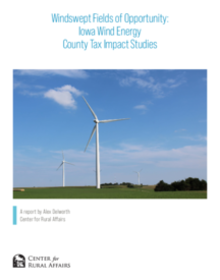Wind energy has been part of the Iowa landscape for decades. Today, the state is the second-largest wind power producer in the nation and has the highest share of net electricity generation, with 58% of production coming from wind in 2021. As demand for renewable energy continues to rise, Iowa’s wind energy capacity is expected to grow from 12,219 megawatts (MW) to more than 14,700 MW in the next several years.
In the past 10 years, Iowa has seen a 166% increase in net wind generation, with another 1,000 MWs expected to come online in 2022.
Wind development can provide significant economic benefits to local governments, which assess and collect property taxes on systems within their county borders. These property taxes apply to all of the wind-energy conversion property, which includes the turbine itself, electrical equipment, power lines, substations, and transformers.
In 2021, Iowa wind turbines generated approximately $57 million in tax revenues for state and local taxing bodies, and the wind companies paid out $67 million in lease payments to landowners. Counties use the money to support essential services such as education, infrastructure, emergency services, and law enforcement.
In this report, we examine the impact wind-energy tax revenue has had on three Iowa counties: Story, Ida, and Marshall. First, we outline how this revenue is collected and the options counties have at their disposal. This provides a full understanding of the benefits these projects pose to counties in Iowa. Then, we dive into specific case studies featuring individual counties and how they tax their wind turbines, the financial impact and special projects completed as a result, and their plans going forward.
Click here to read " Report Recap: Windswept Fields of Opportunity: Iowa Wind Energy County Tax Impact Studies."


